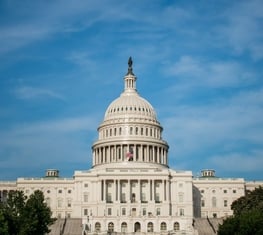LWVUS sent a letter to members of the House Energy and Commerce Committee urging them to minimize cuts to Medicaid. Medicaid insures 1 in 5 Americans, and cuts to the program would cause shortfalls in state budgets and eliminate essential care for millions of Americans, including children, pregnant people, seniors with limited income, and people with disabilities.
May 12, 2025
To: Members of the House Committee on Energy and Commerce
Re: Minimize Medicaid Cuts for Millions of Americans
Dear Representative,
As the House Committee on Energy and Commerce produces its FY 2026-34 appropriations bill, the League of Women Voters of the United States (the “League”) urges you to minimize cuts to Medicaid funding, as they threaten the loss of health care access for millions of Americans.
The House budget resolution requires the House Committee on Energy and Commerce to cut $880 billion over 10 years.[1] As 93% of the Committee’s non-Medicare mandatory spending is on Medicaid, a substantial portion of these cuts will be to Medicaid, constituting the largest Medicaid cuts in history. [2]
Medicaid is the single largest source of health coverage in the country.[3] The program insures nearly 72 million Americans, including children, pregnant people, parents, and seniors with limited incomes, and people with disabilities.[4] These members of our community rely on Medicaid for essential care including doctor visits, hospitalizations, long-term care, maternity care, mental health care, and rural clinic services.[5]
Medicaid is an efficient and vital investment in our nation’s health. Only 3-4% of Medicaid spending goes to administrative costs.[6] Research shows that Medicaid coverage for children is associated with improved health in childhood and adulthood and improved educational outcomes.[7] States that have adopted the Affordable Care Act's expanded Medicaid –making adults with incomes up to 138% of the federal poverty level eligible- have had dramatic reductions in uninsured rates, associated with improved health and financial security.[8]
Insuring 1 in 5 Americans requires a significant federal investment, and many states cannot make up the shortfall of the impending Medicaid cuts. Medicaid, as a joint federal and state program, is predominantly federally funded and is often the largest expenditure in a state budget.[9] Federal funding accounts for between 50 and 77% of the cost of a Medicaid enrollee’s coverage, and 90% for a Medicaid expansion recipient.[10] When Congress cuts Medicaid funding, it will force states to raise taxes, cut other state programs, and/or reduce Medicaid scope of benefits or enrollments for some currently qualifying Americans.[11] According to a Congressional Budget Analysis, depending on the proposal used to cut funding, our country could see a loss of Medicaid coverage for 2.3 to 8.6 million people.[12]
Medicaid has broad bipartisan support with 77% of Americans holding a favorable view of the program.[13] States with Medicaid expansion, which face a higher risk of loss of federal Medicaid funding, also vary in political composition: including 21 states that went Republican and 20 states that went Democrat in the 2024 presidential election.[14]
The League believes that every US resident should have access to a basic level of quality health care at an affordable cost. During the FY 2026-34 appropriations process, we urge you to consider the implications of cuts to Medicaid for your constituents and the greater American people, and to minimize these cuts. With millions at risk of losing their health care access, the health and well-being of our nation hangs in the balance.
Please do not hesitate to reach out to Rebecca Goldman [email protected] if you wish to discuss this issue further.
Sincerely,
Jessica Jones Capparell
Director of Government Affairs
League of Women Voters of the United States
[1]https://www.congress.gov/bill/119th-congress/house-concurrent-resolution/14/text
[2]https://www.cbo.gov/system/files/2025-03/61235-Boyle-Pallone.pdf
[3]https://www.medicaid.gov/medicaid/eligibility-policy
[4]https://www.medicaid.gov/medicaid/program-information/medicaid-and-chip-enrollment-data/report-highlights
[5]https://www.medicaid.gov/medicaid/benefits/mandatory-optional-medicaid-benefits
[6]https://www.macpac.gov/wp-content/uploads/2024/12/EXHIBIT-16.-Medicaid-Spending-by-State-Category-and-Source-of-Funds-FY-2023.pdf
[7]https://aspe.hhs.gov/sites/default/files/documents/effbde36dd9852a49d10e66e4a4ee333/medicaid-health-economic-benefits.pdf
[8]https://www.cbpp.org/research/health/medicaid-expansion-frequently-asked-questions-0
[9]https://www.americanprogress.org/article/how-federal-funding-cuts-could-unravel-medicaid-expansion-in-12-states/
[10]https://www.kff.org/medicaid/state-indicator/federal-matching-rate-and-multiplier/?currentTimeframe=0&sortModel=%7B%22colId%22:%22Multiplier%22,%22sort%22:%22desc%22%7D
[11] https://www.kff.org/medicaid/issue-brief/putting-880-billion-in-potential-federal-medicaid-cuts-in-context-of-state-budgets-and-coverage/
[12]https://www.cbo.gov/system/files/2025-05/Wyden-Pallone_Letter.pdf
[13]https://www.kff.org/medicaid/poll-finding/7-charts-about-public-opinion-on-medicaid/
[14]https://www.kff.org/medicaid/issue-brief/10-things-to-know-aboutmedicaid/#:~:text=In%202023%2C%20Medicaid%20covered%20nearly,have%20adopted%20the%20Medicaid%20expansion.
Sign Up For Email
Keep up with the League. Receive emails to your inbox!
Donate to support our work
to empower voters and defend democracy.




